Assessment of Spray Drift with Various Adjuvants in a Wind Tunnel
Abstract
:1. Introduction
2. Materials and Methods
2.1. Adjuvants
2.2. The Wind Tunnel
2.3. Wind Tunnel Experiments
3. Results
3.1. Effects of Adjuvants on Viscosity and Surface Tension of Spray
3.2. Effects of Adjuvants on the Droplet Diameter of Spray
3.3. Effects of Adjuvants in Reducing the Potential for Ground Spray Drift
3.4. Effects of the Adjuvants on the Reduction of Airborne Drift Potential of Spray
4. Discussions
5. Conclusions
- (1)
- As predicted, drift-guard adjuvants lowered the surface tension and increased the viscosity. It was possible to produce coarser droplets under the same conditions by using adjuvants.
- (2)
- Drift-prone droplets (<100 μm) were decreased by using an adjuvant compared to using tap water due to coarsening of the droplets.
- (3)
- The ground spray drift was decreased by using adjuvants. As the pressure and the wind velocity increased, the Dc value also increased. The Control Duo adjuvant reduced the ground drift by up to 60.53%.
- (4)
- As the height of the polyethylene lines increased, the deposition on those lines decreased. Increases in the pressure and wind velocity caused deposition increases for each height. The maximum DPRP value was obtained as 85.76% with the Surfeco plus adjuvant containing organic silicone.
Author Contributions
Funding
Conflicts of Interest
References
- Oerke, E.C. Crop losses to pests. J. Agric. Sci. 2006, 144, 31–43. [Google Scholar] [CrossRef]
- Hewitt, A.J. Spray drift: Impact of requirements to protect the environment. Crop Prot. 2000, 19, 623–627. [Google Scholar] [CrossRef]
- De Schampheleire, M.; Spanoghe, P.; Brusselman, E.; Snock, S. Risk assessment of pesticide spray drift damage in Belgium. Crop Prot. 2007, 26, 602–611. [Google Scholar] [CrossRef]
- Nuyttens, D.; De Schampheleire, M.; Baetens, K.; Sonck, B. The influence of operator controlled variables on spray drift from field crop sprayers. Trans. ASABE 2007, 50, 1129–1140. [Google Scholar] [CrossRef]
- De Schampheleire, M.; Nuyttens, D.; Baetens, K.; Cornelis, W.; Gabriels, D.; Spanoghe, P. Effects on pesticide spray drift of the physicochemical properties of the spray liquid. Precis. Agric. 2009, 10, 409–420. [Google Scholar] [CrossRef]
- De Ruiter, H.; Holterman, H.J.; Kempenaar, C.; Mol, H.G.J.; de Vlieger, J.J.; van de Zande, J. Influence of Adjuvants and Formulations on the Emission of Pesticides to the Atmosphere. In A Literature Study for the Dutch Research Programme Pesticides and the Environment (DWK) Theme C-2; Report 59; Plant Research International B.V.: Wageningen, The Netherlands, 2003. [Google Scholar]
- Butler-Ellis, M.C.; Swan, T.; Miller, P.C.H.; Waddelow, S.; Bradley, A.; Tuck, C.R. Design factors affecting spray characteristics and drift performance of air induction nozzles. Biosyst. Eng. 2002, 82, 289–296. [Google Scholar]
- Vallet, A.; Tinet, C. Characteristics of droplets from single and twin jet air induction nozzles: A preliminary investigation. Crop Prot. 2013, 48, 63–68. [Google Scholar] [CrossRef]
- Western, N.M.; Hislop, E.C. Drift of charged and uncharged spray droplets from an experimental air-assisted sprayer. In: Air-Assisted in Crop Protection. BCPC Monogr. 1991, 46, 69–76. [Google Scholar]
- Hislop, E.C.; Western, N.M.; Cooke, B.K.; Butler, R. Experimental air-assisted spraying of young cereal plants under controlled conditions. Crop Prot. 1993, 12, 193–200. [Google Scholar] [CrossRef]
- Bayat, A.; Ozkan, H.E.; Derksen, R.C.; Fox, R.D.; Brazee, R.D. Wind tunnel evaluation of air-assist sprayer operating parameters. ASAE Meet. Present. 1999, 18–22. [Google Scholar] [CrossRef]
- Patel, M.K. Technological improvements in electrostatic spraying and its impact on agriculture during the last decade and future research perspectives: A review. Eng. Agric. Environ. Food 2016, 9, 92–100. [Google Scholar] [CrossRef]
- Martin, D.E.; Lateef, M.A. Aerial Electrostatic spray deposition and canopy penetration in cotton. J. Electrost. 2017, 90, 38–44. [Google Scholar] [CrossRef]
- Ozkan, H.E.; Miralles, A.; Sinfort, C.; Zhu, H.; Fox, R.D. Shields to reduce spray drift. J. Agric. Eng. Res. 1997, 67, 311–322. [Google Scholar] [CrossRef]
- Tsay, J.; Ozkan, H.E.; Brazee, R.D.; Fox, R.D. CFD simulation of moving spray shields. Trans. ASAE 2002, 45, 21–26. [Google Scholar]
- Sidahmed, M.M.; Awadalla, H.H.; Haidar, M. Symmetrical multi-foil shields for reducing spray drift. Biosyst. Eng. 2004, 88, 305–312. [Google Scholar] [CrossRef]
- Zhu, H.; Dexter, R.W.; Fox, R.D.; Reichard, D.L.; Brazee, R.D.; Ozkan, H.E. Effects of polymer composition and viscosity on droplet size of recirculated spray solutions. J. Agric. Eng. Res. 1997, 67, 35–45. [Google Scholar] [CrossRef]
- Hilz, E.; Vermeer, A.W.P. Spray drift review: The extent to which a formulation can contribute to spray drift reduction. Crop Prot. 2013, 44, 75–83. [Google Scholar] [CrossRef]
- Wang, S.; Li, X.; Zeng, A.; Song, J.; Xu, T.; Lv, X.; He, X. Effects of Adjuvants on Spraying Characteristics and Control Efficacy in Unmanned Aerial Application. Agriculture 2022, 12, 138. [Google Scholar] [CrossRef]
- Ellis, J.M.; Griffin, J.L. Soybean (Glycine max) and Cotton (Gossypium hirsutum) response to simulated drift of glyphosate and glufosinate. Weed Technol. 2002, 16, 580–586. [Google Scholar] [CrossRef]
- Koger, C.H.; Shaner, D.L.; Krutz, L.J.; Walker, T.W.; Buehring, N.; Henry, W.B.; Thomas, W.E.; Wilcut, J.W. Rice (Oriza sativa) response to drift rates of glyphosate. Pest Manag. Sci. 2005, 61, 1161–1167. [Google Scholar] [CrossRef]
- Schrübbers, L.; Valverde, B.E.; Sørensen, J.C.; Cedergreen, N. Glyphosate spray drift in Coffea arabica—sensitivity of coffee plants and possible use of shikimic acid as a biomarker for glyphosate exposure. Pest. Biochem. Physiol. 2014, 115, 15–22. [Google Scholar] [CrossRef] [PubMed]
- Lan, Y.; Hoffmann, W.C.; Fritz, B.K.; Martin, D.E.; Lopez, J.D. Spray drift mitigation with spray mix adjuvants. Appl. Eng. Agric. 2008, 24, 5–10. [Google Scholar] [CrossRef]
- Alves, G.S.; Kruger, G.R.; da Cunha, J.P.A.R.C.; Vieira, B.C.; Henry, R.S.; Obradovic, A.; Grujic, M. Spray Drift from Dicamba and Glyphosate Applications in a Wind Tunnel. Weed Technol. 2017, 31, 387–395. [Google Scholar] [CrossRef]
- Bayat, A.; Bozdogan, N.Y. An air-assisted spinning disc nozzle and its performance on spray deposition and reduction of drift potential. Crop Prot. 2005, 24, 951–960. [Google Scholar] [CrossRef]
- Nuyttens, D.; Taylor, W.A.; Schampheleire, M.; Verbhoven, P.; Dekeyser, D. Influence of nozzle type and size on drift potential by means of different wind tunnel evaluation methods. Biosyst. Eng. 2009, 103, 271–280. [Google Scholar] [CrossRef]
- Reichard, L.; Zhu, H.; Fox, R.D.; Brazee, R.D. Computer Simulation of Varıables That Influence Spray Drıft. Trans. ASAE 1992, 35, 1401–1407. [Google Scholar] [CrossRef]
- Grella, M.; Gil, E.; Balsari, P.; Marucco, P.; Gallart, M. Advances in developing a new test method to assess spray drift potential from air blast sprayers. Span. J. Agric. Res. 2017, 15, 16. [Google Scholar] [CrossRef] [Green Version]
- Nuyttens, D.; Zwertvaegher, I.K.A.; Dekeyser, D. Spray drift assessment of different application techniques using a drift test bench and comparison with other assessment methods. Biosyst. Eng. 2017, 154, 14–24. [Google Scholar] [CrossRef]
- Spanoghe, P.; De Schampheleire, M.; Van der Meeren, P.; Steurbaut, W. Review Influence of agricultural adjuvants on droplet spectra. Pest. Manag. Sci. 2007, 63, 4–16. [Google Scholar] [CrossRef]
- Curran, W.S.; Mcglamery, M.D.; Liebl, R.A.A.; Lingenfelter, D.D. Adjuvants for Enhancing Herbicide Performance; Agronomy Facts 37; Penn State College of Agricultural Sciences: University Park, PA, USA, 1999. [Google Scholar]
- Silicone Spectator. Available online: http://www.scientificspectator.com/documents/silicone%20spectator/Silicone_Spectator_July_2009.pdf (accessed on 21 May 2021).
- De Oliveira, R.B.; Antuniassi, U.R.; Gandolfo, M.A. Spray Adjuvant Characteristics Affecting Agricultural Spraying Drift. Eng. Agríc. 2015, 35, 109–116. [Google Scholar] [CrossRef] [Green Version]
- Griesang, F.; Decaro, R.A.; Santos, C.A.M.; Santos, E.S.; Roque, N.H.L.; Ferreira, M.C. How much do adjuvant and nozzles models reduce the spraying drift? Drift in agricultural spraying. Am. J. Plant Sci. 2017, 8, 2785–2794. [Google Scholar] [CrossRef] [Green Version]
- Butler-Ellis, M.C.; Tuck, C.R.; Miller, P.C.H. The effect of some adjuvants on sprays produced by agricultural flat fan nozzles. Crop Prot. 1997, 16, 41–50. [Google Scholar] [CrossRef]
- Guler, H.; Zhu, H.; Ozkan, E.; Derksen, R.; and Krause, C. Wind Tunnel Evaluation of Drift Reduction Potential and Spray Characteristics with Drift Retardants at High Operating Pressure. J. ASTM Int. 2006, 3, 1–9. [Google Scholar] [CrossRef] [Green Version]
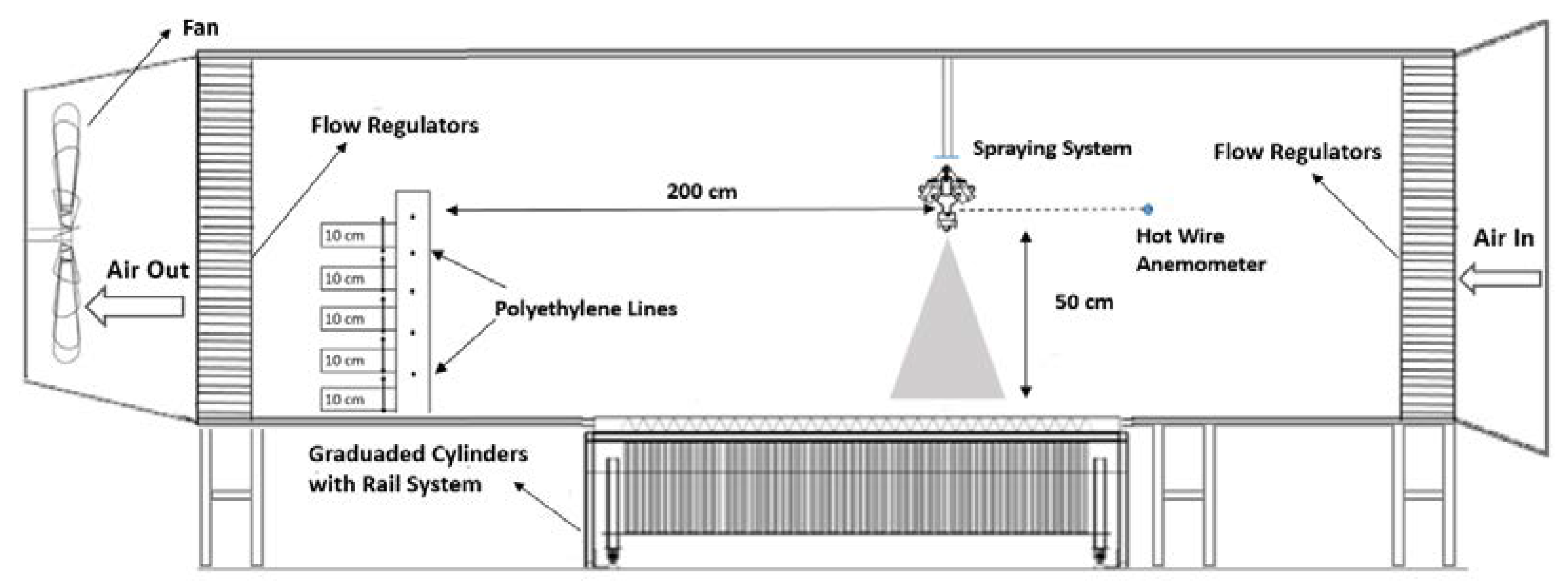
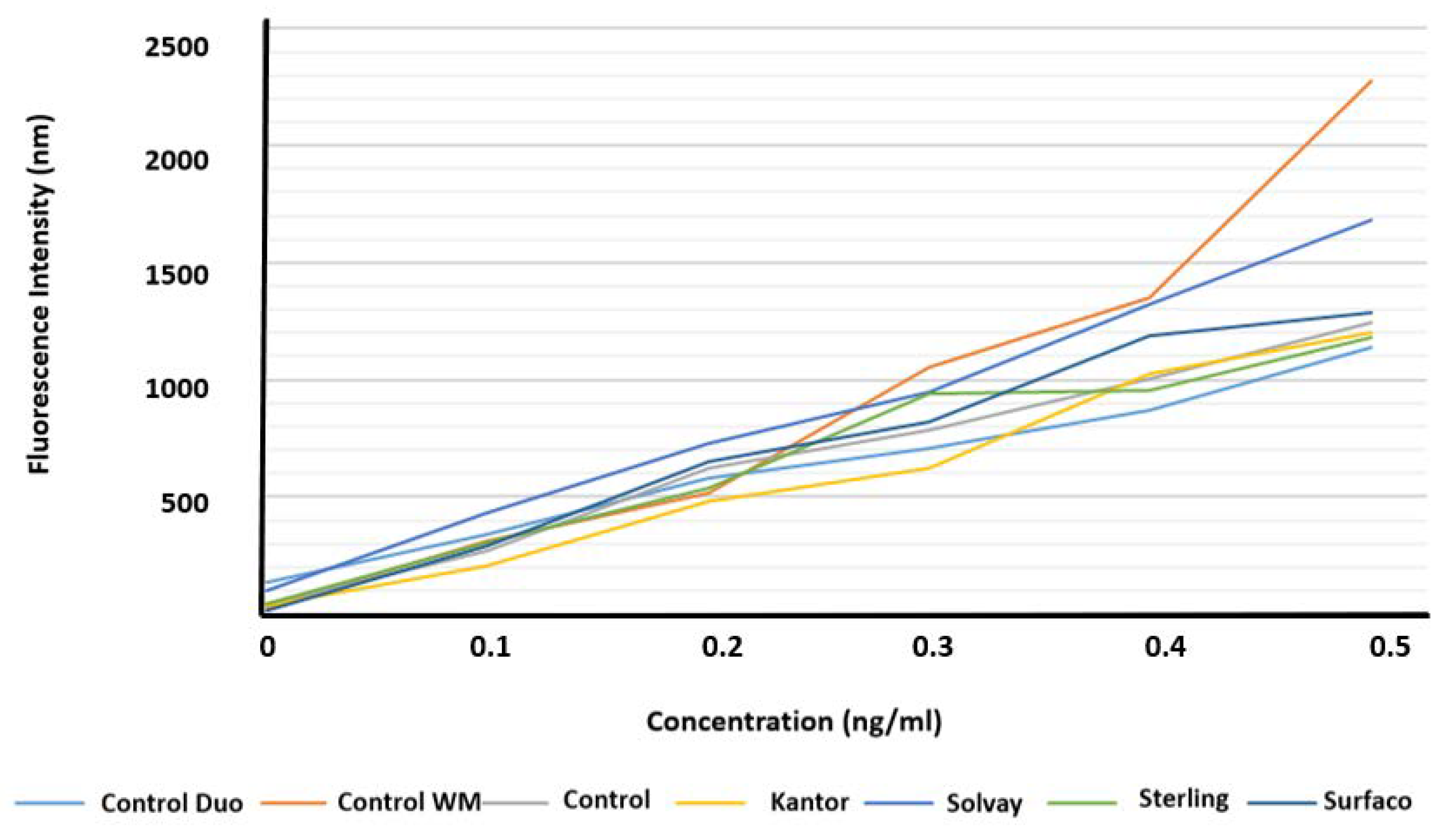
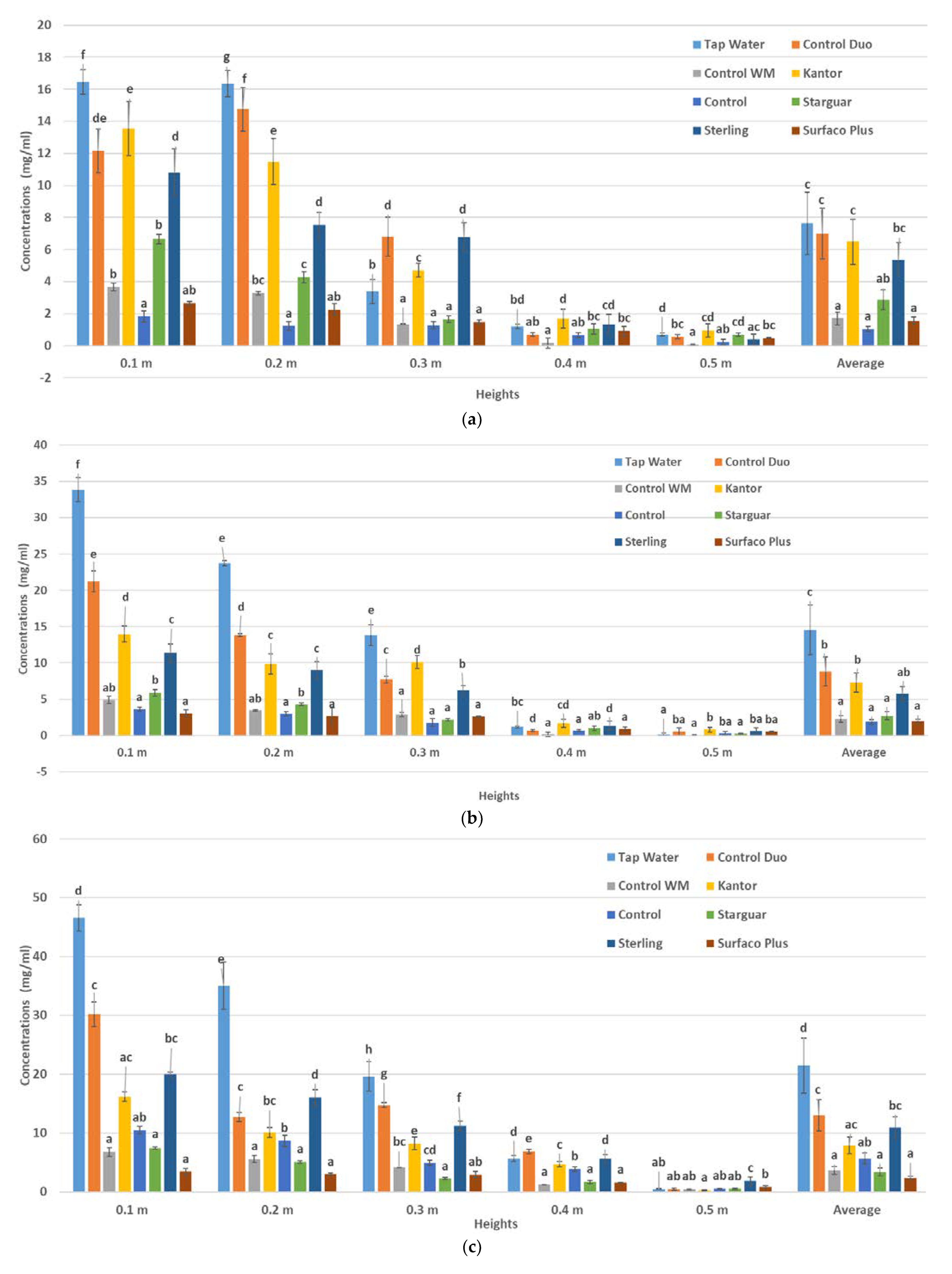
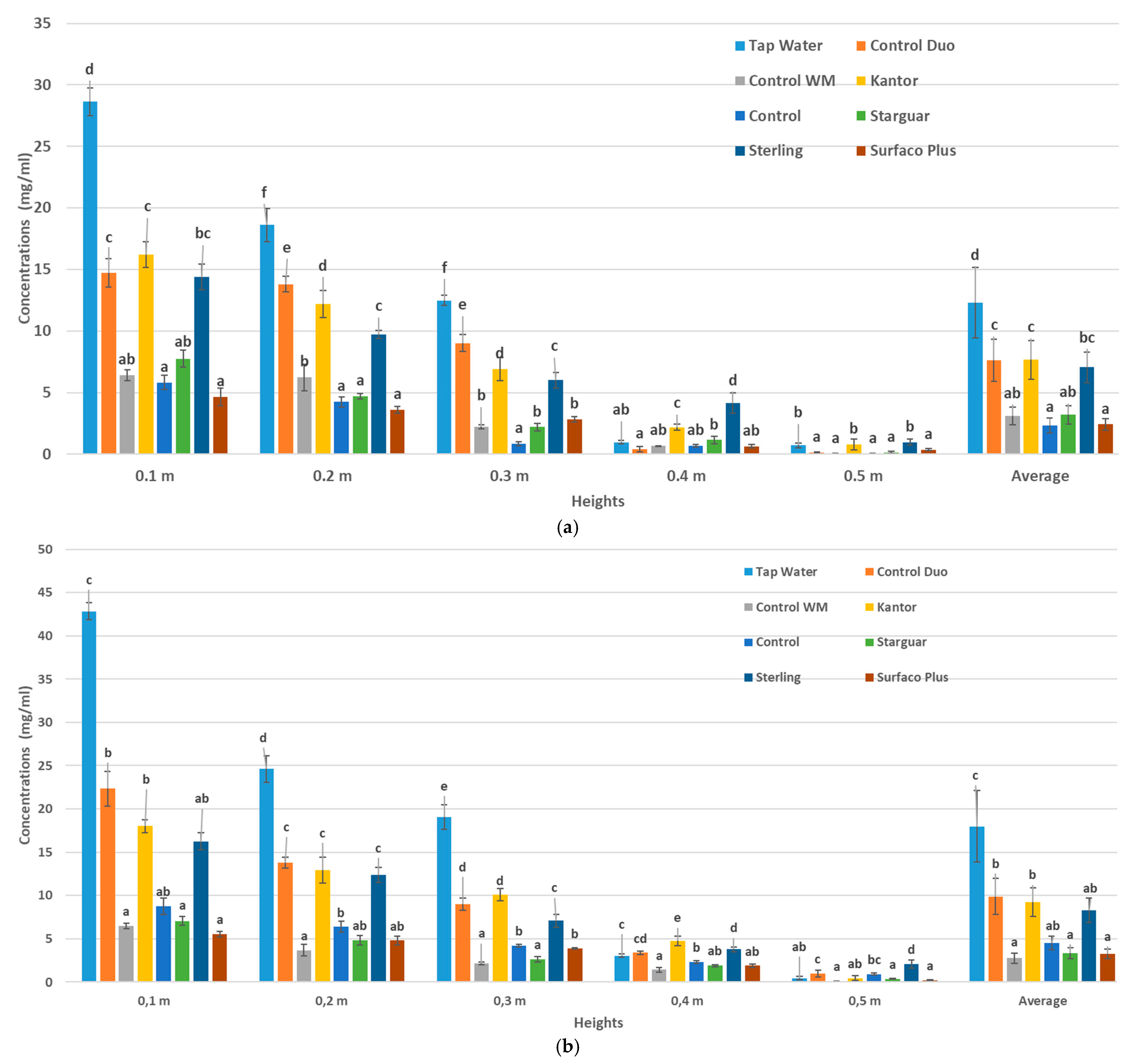
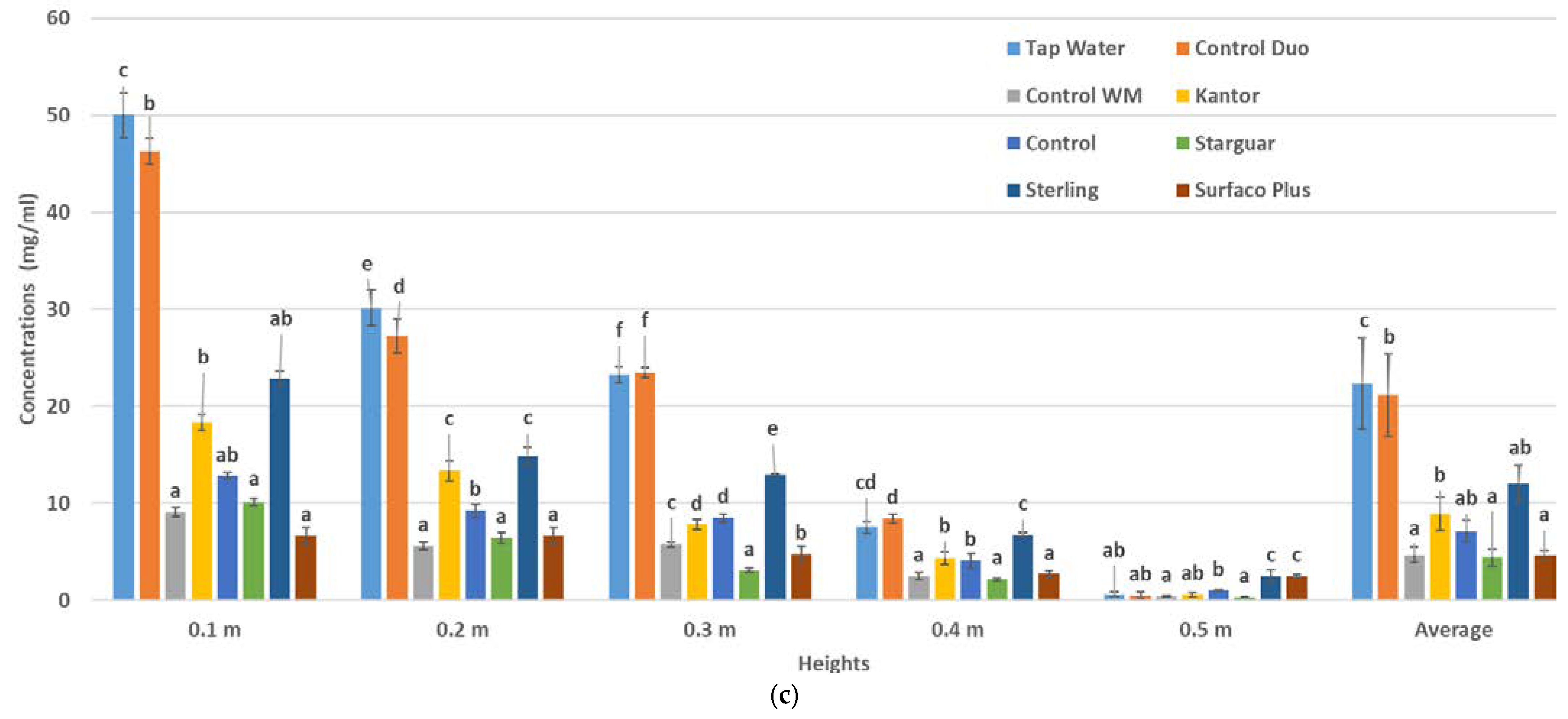
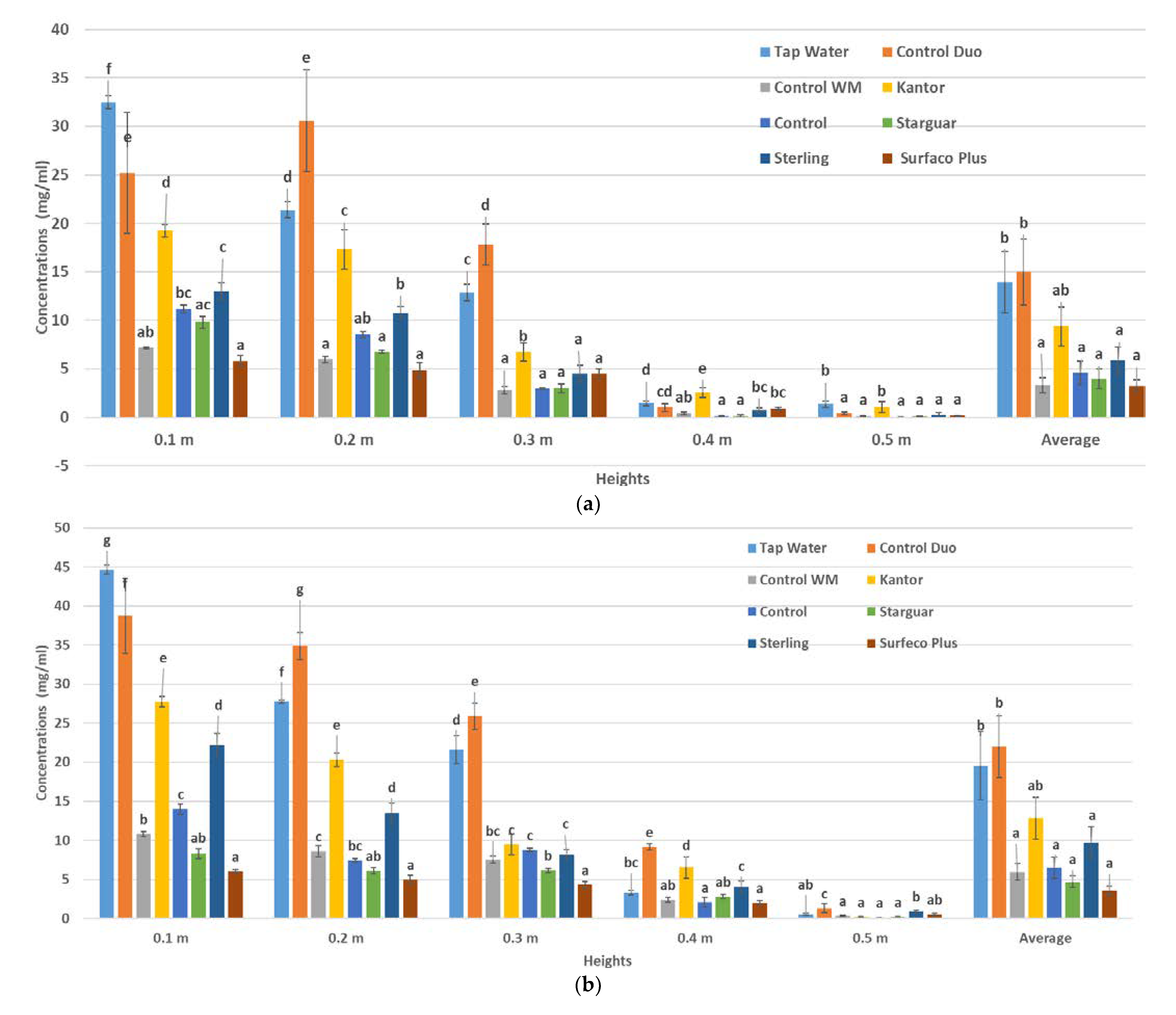
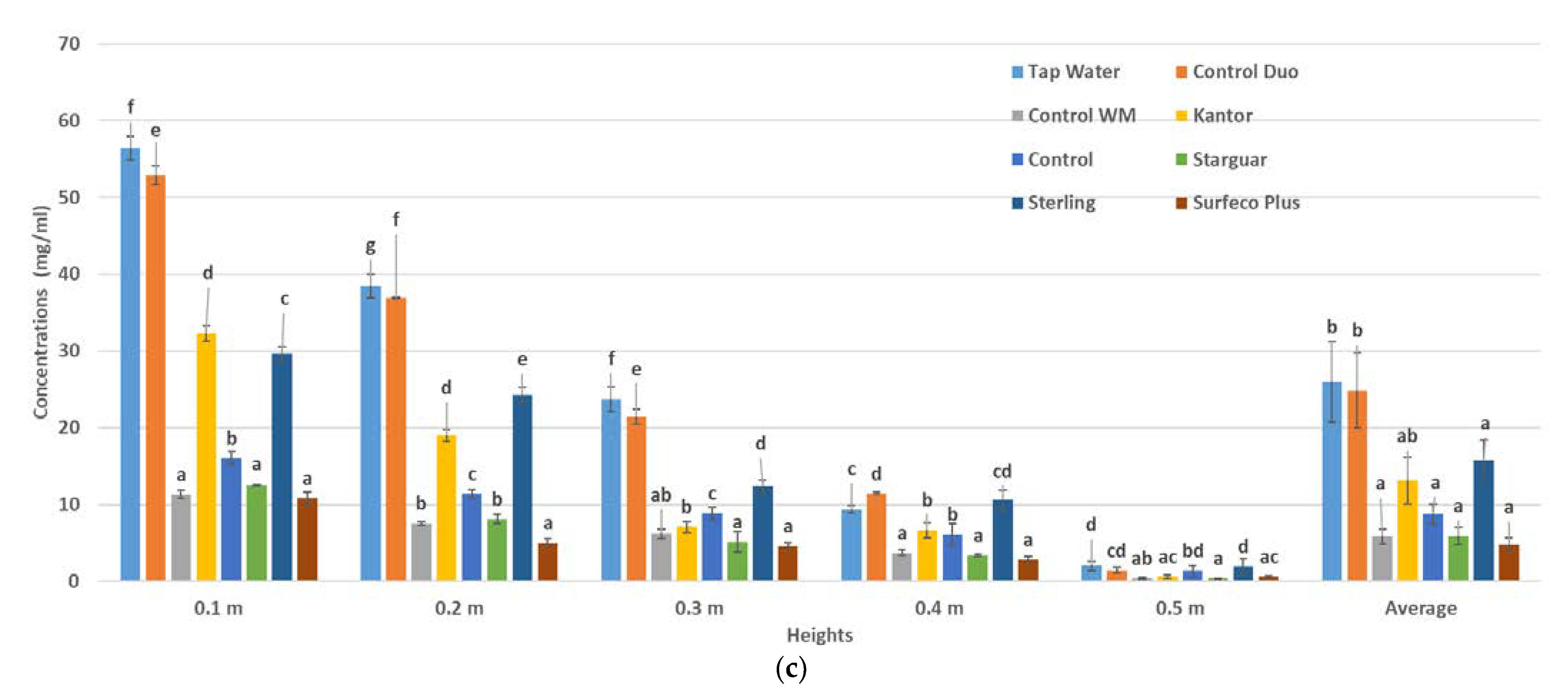
| Commercial Name | Producing Company | Active Ingredient | Property | Recommended Concentration (mL/L) |
|---|---|---|---|---|
| Surfeco plus | Momentive (New York, NY, USA) | Organic silicone | Drift guard | 0.15 |
| Starguar | Solvay (Lyon, France) | Methylated oil-based | Drift guard | 0.25 |
| Kantor | İnteragro (London, UK) | Alkoxylated triglycerides | Drift guard | 0.15 |
| Sterling | İnteragro (London, UK) | Triglycerides | Drift guard | 0.25 |
| Control | Garrco (Indiana, IN, USA) | Polyvinyl polymer | Drift guard | 0.25 |
| Control WM | Garrco (Indiana, IN, USA) | MAX glyphosate | Drift guard | 0.25 |
| Control DUO | Garrco (Indiana, IN, USA) | Polymer blend | Drift guard | 0.25 |
| Tap Water | Control Duo | Control WM | Kantor | Control | Starguar | Sterling | Surfeco Plus | |
|---|---|---|---|---|---|---|---|---|
| Surface Tension (mN/m) | 75.23 ± 0.1 a | 21.94 ± 0.07 b | 40.57 ± 0.3 c | 45.49 ± 0.11 c | 47.19 ± 0.09 c | 34.81 ± 0.04 bc | 44.37 ± 0.14 c | 21.71 ± 0.06 b |
| Viscosity (mPa.s) | 1.00 ± 0.13 a | 4.27 ± 0.11 b | 2.74 ± 0.14 c | 1.52 ± 0.07 d | 1.42 ± 0.16 d | 1.63 ± 0.17 d | 1.38 ± 0.08 d | 3.24 ± 0.06 cd |
| Mixture | Pressure (bar) | Dv0.5 (μm) | <55 μm (%) | <100 μm (%) | <158 μm (%) | Relative Span |
|---|---|---|---|---|---|---|
| Tap Water | 3 | 156 | 2.56 | 19.98 | 51.67 | 1.32 |
| 4 | 149 | 3.99 | 20.81 | 53.33 | 1.34 | |
| 5 | 144 | 4.95 | 24.82 | 57.11 | 1.31 | |
| Control | 3 | 192 | 1.23 | 9.01 | 34.85 | 1.32 |
| 4 | 166 | 1.73 | 16.08 | 45.18 | 1.33 | |
| 5 | 153 | 2.14 | 21.35 | 48.87 | 1.33 | |
| Control WM | 3 | 183 | 1.50 | 22.08 | 38.74 | 1.36 |
| 4 | 169 | 2.64 | 22.20 | 46.35 | 1.33 | |
| 5 | 156 | 2.97 | 23.80 | 51.79 | 1.34 | |
| Control Duo | 3 | 185 | 1.53 | 16.55 | 37.03 | 1.63 |
| 4 | 168 | 2.92 | 22.60 | 45.48 | 1.68 | |
| 5 | 147 | 3.11 | 27.02 | 53.97 | 1.64 | |
| Surfeco plus | 3 | 191 | 1.44 | 14.33 | 33.99 | 1.29 |
| 4 | 179 | 2.92 | 22.61 | 44.93 | 1.34 | |
| 5 | 159 | 3.07 | 27.28 | 49.82 | 1.31 | |
| Sterling | 3 | 192 | 1.63 | 17.60 | 33.56 | 1.26 |
| 4 | 178 | 3.01 | 23.36 | 41.71 | 1.32 | |
| 5 | 165 | 2.6 | 22.78 | 47.33 | 1.31 | |
| Kantor | 3 | 188 | 1.27 | 13.24 | 41.39 | 1.63 |
| 4 | 182 | 3.47 | 22.48 | 44.52 | 1.63 | |
| 5 | 160 | 2.90 | 21.91 | 49.41 | 1.66 | |
| Starguar | 3 | 191 | 1.12 | 14.32 | 33.82 | 1.42 |
| 4 | 175 | 2.76 | 22.20 | 43.53 | 1.41 | |
| 5 | 166 | 3.33 | 23.20 | 46.97 | 1.43 |
| Pressure (Bar) | Tap Water | Control | Control WM | Control Duo | Surfeco Plus | Sterling | Kantor | Starguar |
|---|---|---|---|---|---|---|---|---|
| Dv0.5 (μm) | Dv0.5 (μm) | Dv0.5 (μm) | Dv0.5 (μm) | Dv0.5 (μm) | Dv0.5 (μm) | Dv0.5 (μm) | Dv0.5 (μm) | |
| 3 | 156 ± 0.2 a | 192 ± 0.1 c | 183 ± 0.3 b | 185 ± 0.1 b | 191 ± 0.2 c | 192 ± 0.4 c | 188 ± 0.4 bc | 191 ± 0.2 c |
| 4 | 149 ± 0.3 a | 166 ± 0.2 b | 169 ± 0.3 b | 168 ± 0.2 b | 179 ± 0.4 c | 178 ± 0.3 c | 182 ± 0.2 c | 175 ± 0.1 c |
| 5 | 144 ± 0.4 a | 153 ± 0.4 bc | 156 ± 0.1 c | 147 ± 0.1 ab | 159 ± 0.3 c | 165 ± 0.1 d | 160 ± 0.3 c | 166 ± 0.3 d |
| Interactions | F | dF | p | |||||
| Pressure * | 16.52 | 2 | 0.00 | |||||
| Adjuvant * | 3.63 | 7 | 0.03 | |||||
| Pressure × Adjuvant * | 1.55 | 14 | 0.00 | |||||
| Pressure (Bar) | Wind Velocity (M/S) | Tap Water | Control Duo | Control WM | Kantor | Control | Starguar | Sterling | Surfeco Plus |
|---|---|---|---|---|---|---|---|---|---|
| Dc (cm) | Dc (cm) | Dc (cm) | Dc (cm) | Dc (cm) | Dc (cm) | Dc (cm) | Dc (cm) | ||
| 3 | 2 | 24.28 a | 13.21 b | 12.01 b | 14.76 b | 12.34 b | 13.08 b | 16.20 c | 16.01 c |
| 3 | 3.5 | 27.84 a | 14.63 b | 12.48 b | 15.26 b | 17.07 bc | 13.46 b | 20.86 c | 18.20 c |
| 3 | 5 | 29.35 a | 15.87 b | 18.25 c | 19.75 c | 19.75 c | 16.74 b | 18.38 c | 20.20 c |
| 4 | 2 | 28.19 a | 13.23 b | 13.33 b | 15.31 b | 14.68 b | 13.21 b | 15.53 b | 14.85 b |
| 4 | 3.5 | 32.23 a | 13.87 b | 14.63 b | 16.29 bc | 16.86 bc | 16.66 bc | 16.55 bc | 18.09 c |
| 4 | 5 | 33.85 a | 15.06 b | 17.69 b | 18.76 bc | 20.87 c | 15.64 b | 17.58 b | 21.39 c |
| 5 | 2 | 31.25 a | 13.36 b | 14.52 b | 14.05 b | 14.64 b | 14.09 b | 14.53 b | 17.66 b |
| 5 | 3.5 | 33.37 a | 13.17 b | 13.71 b | 15.94 b | 18.48 bc | 15.11 b | 14.81 b | 19.92 c |
| 5 | 5 | 34.05 a | 14.95 b | 16.36 b | 17.71 b | 17.14 b | 17.42 b | 16.94 b | 23.21 c |
| Interactions | F | df | p | ||||||
| Pressure * | 0.36 | 2 | 0.03 | ||||||
| Wind Velocity * | 9.74 | 2 | 0.01 | ||||||
| Pressure × Wind Velocity * | 0.15 | 4 | 0.03 | ||||||
| Pressure (Bar) | Wind Velocity (M/S) | Control Duo (%) | Control WM (%) | Kantor (%) | Control (%) | Starguar (%) | Sterling (%) | Surfeco Plus (%) |
|---|---|---|---|---|---|---|---|---|
| 3 | 2 | 45.57 | 50.53 | 39.20 | 49.18 | 46.12 | 33.27 | 34.04 |
| 3 | 3.5 | 47.46 | 55.16 | 45.17 | 38.68 | 51.65 | 25.06 | 34.63 |
| 3 | 5 | 45.95 | 37.83 | 32.72 | 32.70 | 42.97 | 37.38 | 31.17 |
| 4 | 2 | 53.05 | 52.72 | 45.67 | 47.91 | 53.14 | 44.90 | 47.31 |
| 4 | 3.5 | 56.97 | 54.62 | 49.44 | 47.70 | 48.32 | 48.64 | 43.86 |
| 4 | 5 | 55.50 | 47.75 | 44.57 | 38.35 | 53.79 | 48.06 | 36.82 |
| 5 | 2 | 57.26 | 53.55 | 55.04 | 53.17 | 54.92 | 53.51 | 43.48 |
| 5 | 3.5 | 60.53 | 58.93 | 52.22 | 44.63 | 54.72 | 55.61 | 40.31 |
| 5 | 5 | 56.09 | 51.95 | 48.00 | 49.65 | 48.86 | 50.25 | 31.84 |
| Control Duo | Control WM | Kantor | Control | Starguar | Sterling | Surfeco Plus | |||||||||
|---|---|---|---|---|---|---|---|---|---|---|---|---|---|---|---|
| Pressure (bar) | Wind Velocity (m/s) | DP | DPRP (%) | DP | DPRP (%) | DP | DPRP (%) | DP | DPRP (%) | DP | DPRP (%) | DP | DPRP (%) | DP | DPRP (%) |
| 3 | 2 | 6.76 | −0.02 | 1.52 | 77.55 | 6.21 | 7.99 | 1.18 | 82.58 | 2.77 | 59.02 | 5.34 | 20.90 | 1.77 | 73.82 |
| 3 | 3.5 | 7.74 | 39.62 | 2.14 | 83.30 | 7.49 | 41.62 | 1.91 | 85.13 | 2.63 | 79.46 | 5.68 | 55.72 | 2.25 | 82.45 |
| 3 | 5 | 12.95 | 35.54 | 3.75 | 81.33 | 8.13 | 59.55 | 6.06 | 69.84 | 3.37 | 83.25 | 11.73 | 41.60 | 2.86 | 85.76 |
| 4 | 2 | 7.16 | 35.39 | 2.84 | 74.36 | 7.40 | 33.21 | 1.98 | 82.09 | 2.91 | 73.74 | 7.33 | 33.84 | 2.48 | 77.66 |
| 4 | 3.5 | 9.53 | 41.74 | 2.64 | 83.86 | 9.54 | 41.67 | 4.79 | 70.71 | 3.40 | 79.22 | 8.78 | 46.36 | 3.54 | 78.37 |
| 4 | 5 | 20.75 | 2.82 | 4.97 | 76.72 | 8.89 | 58.37 | 7.84 | 63.27 | 4.26 | 80.04 | 13.11 | 38.60 | 5.79 | 72.88 |
| 5 | 2 | 14.58 | −15.29 | 2.98 | 76.43 | 8.94 | 29.35 | 3.76 | 70.29 | 3.34 | 73.57 | 5.22 | 58.74 | 3.35 | 73.56 |
| 5 | 3.5 | 22.93 | −26.83 | 6.19 | 65.78 | 12.38 | 31.51 | 6.40 | 64.62 | 5.09 | 71.83 | 9.40 | 48.04 | 3.96 | 78.11 |
| 5 | 5 | 24.39 | 3.05 | 6.16 | 75.51 | 12.10 | 51.92 | 9.64 | 61.69 | 5.92 | 76.46 | 16.72 | 33.52 | 4.89 | 80.55 |
Publisher’s Note: MDPI stays neutral with regard to jurisdictional claims in published maps and institutional affiliations. |
© 2022 by the authors. Licensee MDPI, Basel, Switzerland. This article is an open access article distributed under the terms and conditions of the Creative Commons Attribution (CC BY) license (https://creativecommons.org/licenses/by/4.0/).
Share and Cite
İtmeç, M.; Bayat, A.; Bolat, A.; Toraman, M.C.; Soysal, A. Assessment of Spray Drift with Various Adjuvants in a Wind Tunnel. Agronomy 2022, 12, 2377. https://doi.org/10.3390/agronomy12102377
İtmeç M, Bayat A, Bolat A, Toraman MC, Soysal A. Assessment of Spray Drift with Various Adjuvants in a Wind Tunnel. Agronomy. 2022; 12(10):2377. https://doi.org/10.3390/agronomy12102377
Chicago/Turabian Styleİtmeç, Medet, Ali Bayat, Ali Bolat, Muhammed Cemal Toraman, and Alper Soysal. 2022. "Assessment of Spray Drift with Various Adjuvants in a Wind Tunnel" Agronomy 12, no. 10: 2377. https://doi.org/10.3390/agronomy12102377
APA Styleİtmeç, M., Bayat, A., Bolat, A., Toraman, M. C., & Soysal, A. (2022). Assessment of Spray Drift with Various Adjuvants in a Wind Tunnel. Agronomy, 12(10), 2377. https://doi.org/10.3390/agronomy12102377






